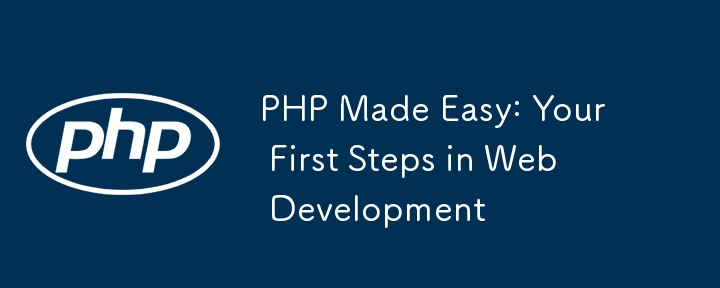Home >Backend Development >PHP Tutorial >PHP Made Easy: Your First Steps in Web Development
PHP Made Easy: Your First Steps in Web Development
- WBOYWBOYWBOYWBOYWBOYWBOYWBOYWBOYWBOYWBOYWBOYWBOYWBOriginal
- 2024-10-11 14:21:211530browse
Introduction to PHP: PHP is an open source web development scripting language. PHP syntax is simple and suitable for beginners. Basic syntax: Use the bb9bd6d87db7f8730c53cb084e6b4d2d tag to represent PHP code. Variables start with a $ symbol (example: $username). Data types include strings, numbers, floats, booleans, and arrays. Conditional statements (such as if) control the flow of code based on conditions. Loops (such as for) allow blocks of code to be executed repeatedly. PHP supports connections to databases such as MySQL. Practical example: Create a PHP script that displays "Hello, World!" and the current time.

PHP Made Easy: Your First Steps in Web Development
Introduction
PHP (Hypertext Preprocessor) is a popular open-source scripting language widely used for web development. It's known for its simplicity and flexibility, making it ideal for beginners. This article will guide you through the basics of PHP and provide a practical example to help you get started.
Setting Up PHP
To run PHP scripts, you'll need a web server with PHP installed. Popular web servers include Apache, Nginx, and IIS. Once PHP is installed, you can create and edit PHP files using any text editor or IDE.
Basic Syntax
PHP uses a combination of tags and PHP code enclosed in them. The basic syntax looks like this:
<?php // PHP code here ?>
Variables
Variables store data in PHP and have a dollar sign ($) before their name:
$username = "John Doe"; $age = 25;
Data Types
PHP supports various data types, including strings, integers, floats, booleans, and arrays. You can use functions like gettype() to check the type of a variable.
Conditionals
Conditional statements control the flow of your code based on certain conditions:
if ($username == "John Doe") {
echo "Welcome, John!";
} else {
echo "Who are you?";
}Loops
Loops allow you to repeat a block of code multiple times:
for ($i = 0; $i < 10; $i++) {
echo "Number: $i";
}Connecting to a Database
PHP has built-in support for connecting to databases, such as MySQL and PostgreSQL:
$servername = "localhost"; $username = "root"; $password = ""; $dbname = "myDB"; // Create connection $conn = new mysqli($servername, $username, $password, $dbname);
Practical Example
Let's create a simple PHP script that displays a greeting message and the current time:
<!DOCTYPE html>
<html>
<head>
<title>My PHP Script</title>
</head>
<body>
<h1><?php echo "Hello, World!"; ?></h1>
<p>Current time: <?php echo date("h:i"); ?></p>
</body>
</html>Conclusion
This article provided a quick overview of the basics of PHP. By understanding its syntax, data types, and control structures, you can begin building simple PHP applications. As you gain experience, you can explore more advanced features and use PHP to create dynamic and interactive web pages.
The above is the detailed content of PHP Made Easy: Your First Steps in Web Development. For more information, please follow other related articles on the PHP Chinese website!

